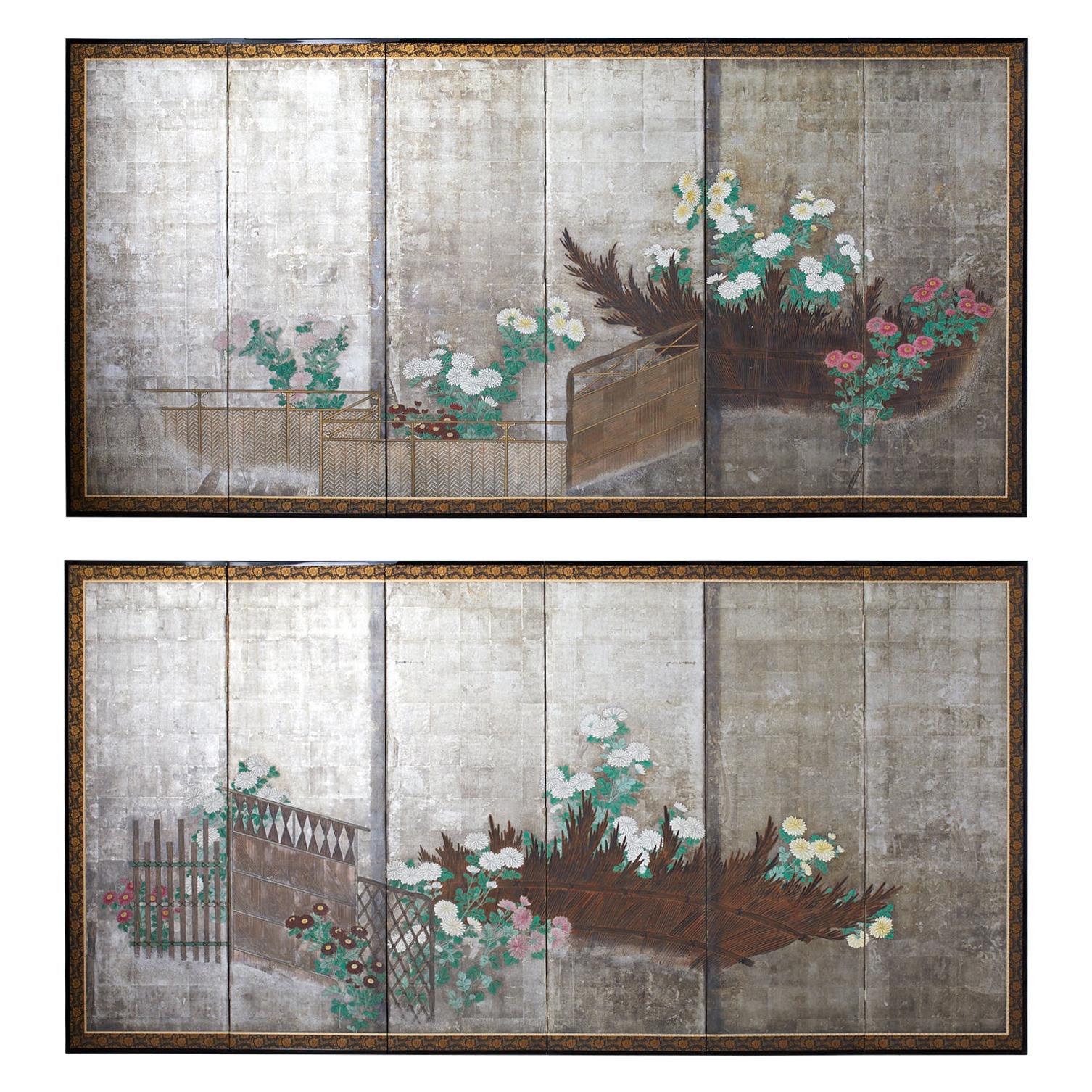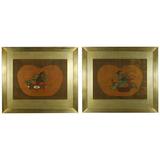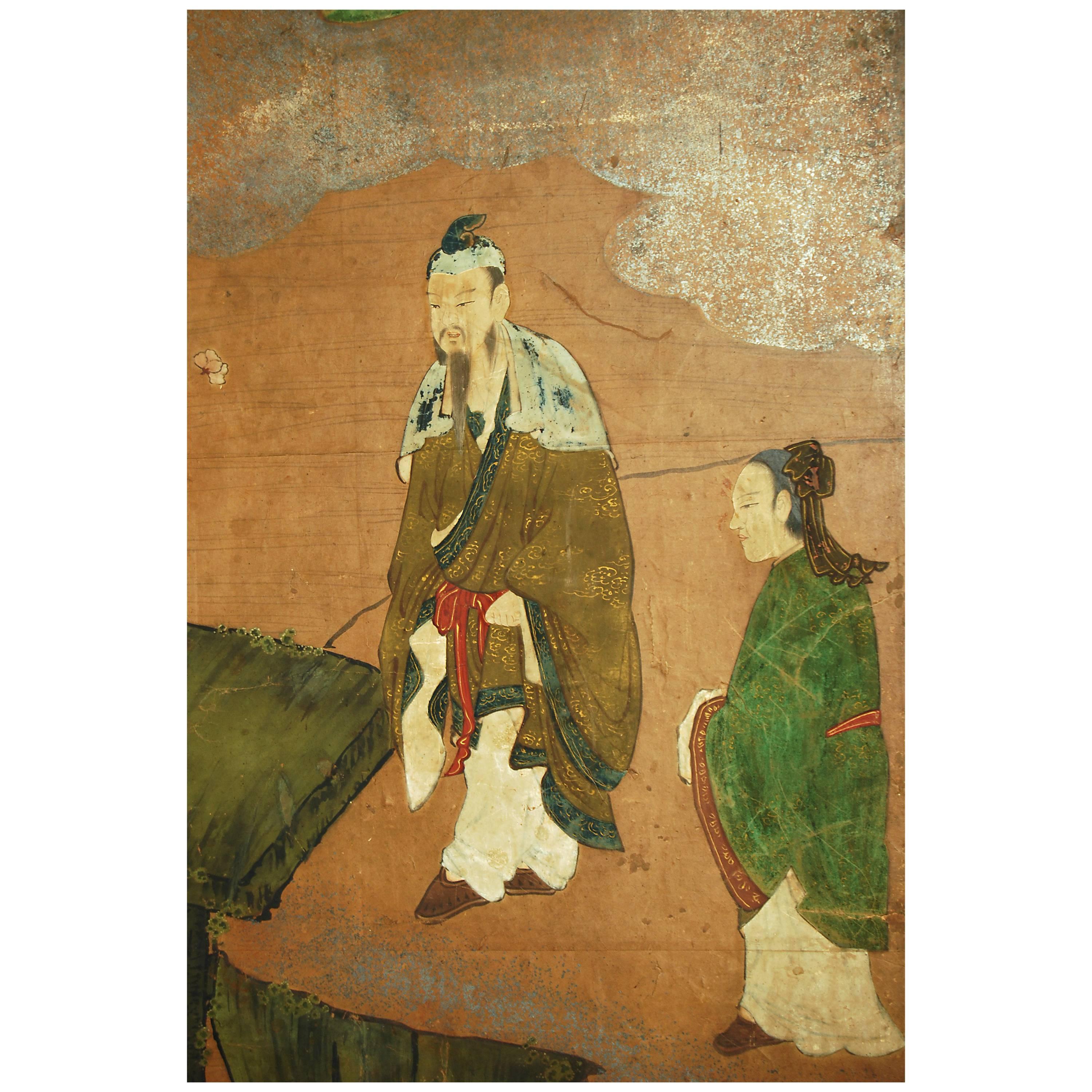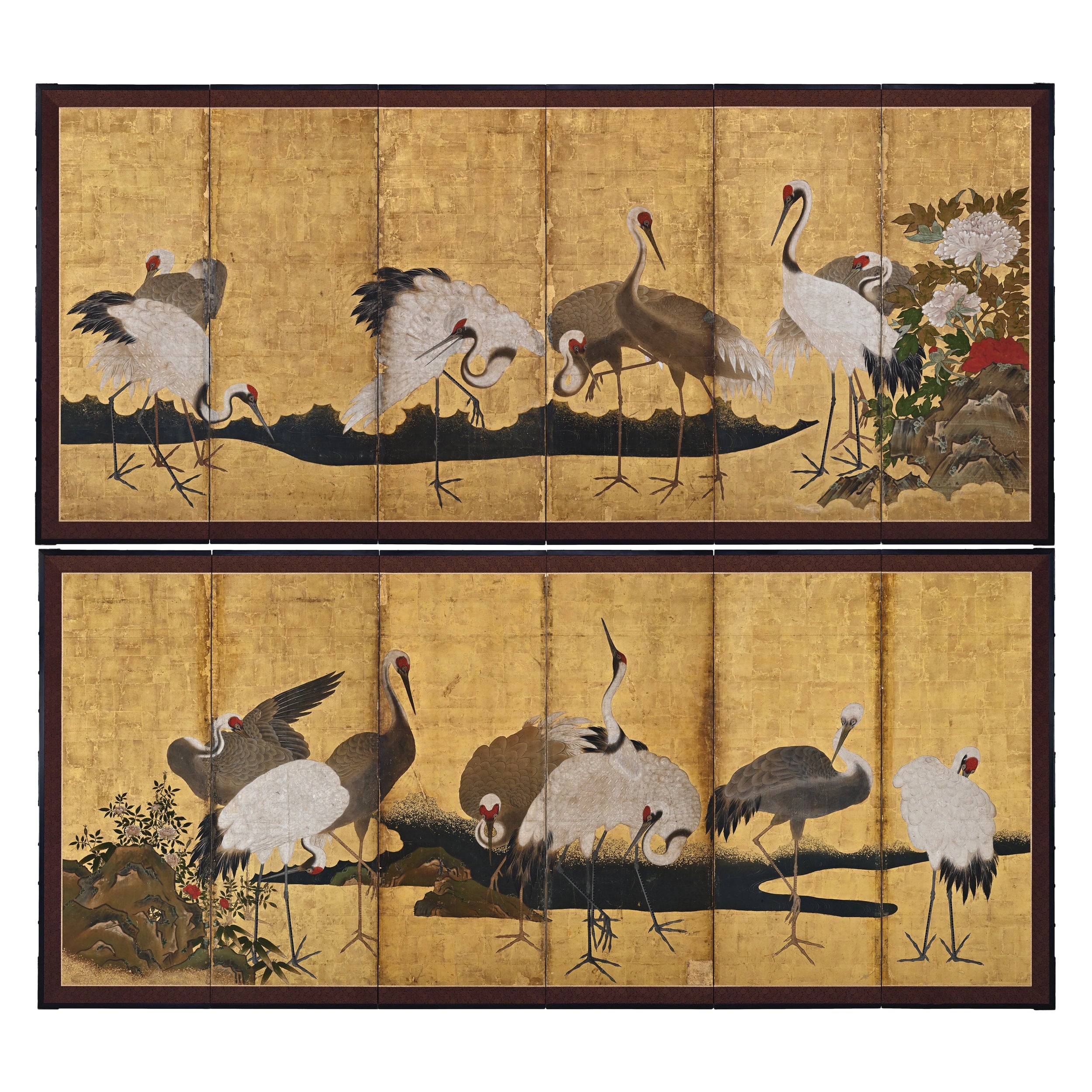Items Similar to Mid-18th Century Japanese Screen Pair, One Hundred Flowers, Chrysanthemums
Want more images or videos?
Request additional images or videos from the seller
1 of 11
Mid-18th Century Japanese Screen Pair, One Hundred Flowers, Chrysanthemums
About the Item
Omori Soun (b. 1704)
Chrysanthemums - One Hundred Flowers
A Pair of Six-fold Japanese Screens. Ink, color, gofun and gold leaf on paper.
Dating to the mid 18th century this pair of six-panel Japanese screens feature a profusion of large, full blossomed chrysanthemum (kiku) flowers. White blooms elaborated with gofun and luxuriant green leaves protrude daringly from the woven straw fences and earthen mounds while sprigs of Japanese dwarf bamboo intersperse the chrysanthemum stalks. The large chrysanthemum’s in full bloom, dwarfing the fences and earthen mounds, convey a strong sense of the life of the flowers and represent an unabashed celebration of the season of autumn. The flowers are executed in a gesso-like technique called moriage which consists of building up the pattern in relief with a very finely powdered oyster shell-white mixture (gofun) combined with water and a binder. Chrysanthemums are a common subject in Japanese screen painting but rarely on such a bold and singular scale. This pair of mid 18th century screens with their lavish paintings and free form express the beauty of nature simply and clearly.
Chrysanthemum (kiku) was introduced from China well over 1000 years ago with the focus on the plant's medical uses. By the Heian period chrysanthemums were already cultivated as ornamental plants. Since then, with the evolution of a native artistic sensibility heavily influenced by the passing seasons, the flower gained its place as one of the foremost symbols of autumn. Compositions such as this screen pair are known in Japanese as hyakka zu (painting of one hundred flowers).
Omori Soun (b. 1704) studied under the Kyoto court artist Tsuruzawa Tanzan. His original name is Morikazu. He is known to have attained the ranks of Hokkyo in 1767 and Hogan in 1773. The present work predates 1767. Relatively little is known of the artist these days but surviving sources suggest that he was a highly renowned painter during his time. In his 30s to 40s, he drew picture models and book illustrations. Ehon Fukujukai, illustrated by Soun, was repeatedly retitled and republished at bookstores in Osaka, suggesting that he had a deep connection with Osaka. In 1765 he painted the fusuma (sliding doors) of Onjoji Homyoin; a sub-temple of Miidera in Otsu. In 1770 he also painted fusuma paintings for the Sento Imperial Palace in Kyoto.
- Dimensions:Height: 67.5 in (171.45 cm)Width: 149 in (378.46 cm)Depth: 0.75 in (1.91 cm)
- Sold As:Set of 2
- Style:Edo (Of the Period)
- Materials and Techniques:
- Place of Origin:
- Period:
- Date of Manufacture:circa 1750
- Condition:Wear consistent with age and use.
- Seller Location:Kyoto, JP
- Reference Number:1stDibs: LU2472333297642
About the Seller
5.0
Recognized Seller
These prestigious sellers are industry leaders and represent the highest echelon for item quality and design.
Gold Seller
These expertly vetted sellers are highly rated and consistently exceed customer expectations.
Established in 2001
1stDibs seller since 2016
60 sales on 1stDibs
Typical response time: 6 hours
- ShippingRetrieving quote...Ships From: Kyoto, Japan
- Return PolicyA return for this item may be initiated within 10 days of delivery.
More From This SellerView All
- Meiji Period Japanese Screen Pair, One Hundred Birds by Hasegawa GyokujunLocated in Kyoto, JPOne hundred birds Hasegawa Gyokujun (1863-1921) Meiji period, circa 1900. Ink, color and gofun on silk. Dimensions of each screen: H. 170 cm x W. 190 cm (67’’ x 75”) Despite the title, well over 100 birds are represented in this pair of two-fold Japanese screens (the title functions figuratively to convey the idea of a large number). The monumental work is rendered with a comprehensive and highly complex composition which is exquisitely executed and meticulously colored. More a celebration of naturalism than the traditional “One Hundred Birds” paintings which originated in China. This was a subject matter known for its auspicious meaning as much as its actual depiction of nature. These paintings generally had a phoenix (occasionally peacocks) placed in the center, and the other birds paying homage to it. In this quintessentially Japanese scene painted by Gyokujun, a couple of long-tailed birds modeled after paradise flycatchers are included; these are traditional auspicious motifs in Oriental bird and flower painting and denote themes such as celebration and enduring generations. In addition there is the playful inclusion of single exotic parrot. Even so, the vast majority of the birds and flowers are native to Japan. Reading the scene from right to left, from spring through to autumn, the overwhelming sense is one of movement and haste. It is almost as if the birds are in a race, with the fleetest leading the way forward. Although these native birds were commonly drawn amongst artists of the Shijo school, rarely were they painted with such drama and dynamism. It is not strictly a depiction of sketched birds whose manner was faithfully handed down through the traditions of the Shijo school. Rather we see Gyokujun seeking and achieving new expressions in the heart of the turbulent Meiji period. Hasegawa Gyokujun (1863-1921) was born in Kyoto. He was the eldest son of Hasegawa Gyokuho, a Shijo school painter who studied under Matsumura Keibun. Gyokujun studied painting under his father and became a prominent member of the Kyoto painti ng world from a young age. In 1891 he established the ‘Young Painters Social Club’ along with Takeuchi Seiho, Miyake Gogyo and Taniguchi Kokyo. Also in 1891 he was selected as a judge of the Great Private Paintings Exhibition along with Takeuchi Seiho, Yamamoto Shunkyo...Category
Antique Early 1900s Japanese Meiji Paintings and Screens
MaterialsSilk, Wood
- 17th Century Japanese Screen Pair, CranesLocated in Kyoto, JPCranes Anonymous, Kano School. Edo period, second half of the 17th century. Pair of six-panel screens. Ink, pigment gofun and gold l...Category
Antique 1670s Japanese Edo Paintings and Screens
MaterialsGold Leaf
- Japanese Screen, Early 20th Century Wagtail & Chrysanthemum by Ishizaki KoyoLocated in Kyoto, JPIshizaki Koyo (1884-1947) Wagtail & Chrysanthemum Early 20th century Folding screen in two-panels. Ink, pigments and gofun on gold leaf. Sign: Koyo Seal: Koyo This ...Category
Early 20th Century Japanese Taisho Paintings and Screens
MaterialsGold Leaf
- Japanese Screen Painting, Early 19th Century, Autumn Flowers by Sakai HoitsuLocated in Kyoto, JPA two-fold Japanese screen by the Rimpa school artist Sakai Hoitsu (1761-1828), Japan, 19th century, Edo period. This small Japanese folding screen pai...Category
Antique Early 19th Century Japanese Edo Paintings and Screens
MaterialsWood, Silk
- 17th Century Japanese Screen Pair. Tiger & Dragon by Kaiho YusetsuLocated in Kyoto, JPKaiho Yusetsu (1598-1677) Tiger and Dragon Early Edo Period, Circa 1650 A Pair of Six-fold Japanese Screens. Ink and slight color on paper. Dimensions: Each screen: H. 171 cm x W. 380 cm (67.5’’ x 149.5’’) In this pair of early Edo period Japanese screens a group of tigers prowl in a bamboo grove whipped with fierce wind, while a dragon claws through clouds and mist. The dragon embodies elemental qualities - looming out of the mist, the coils of its body disappearing in the clouds. The dragon is calling for rain, symbolizing spring which is considered the fountain of life. On the other side, the tigers calls for the wind, symbolizing autumn which is considered the end of life. Tigers were familiar motifs within Japanese art from ancient times though the animals were imaginary to the people in the 17th century. While dragons and tigers are usually associated as sacred and ferocious, in this painting, both animals have rather amusing expressions. The tigers appear to glare at the dragon with cat-like eyes, and the look on the swirling dragon’s face appears almost affectionate - lending a playful flair to an otherwise magnificent theme. The tiger and dragon are cosmological symbols of the balancing forces in the world. Screens such as this were originally meant to express the fluctuating nature of the world. For Japanese in the early Edo period, they likely suggested the powers of the cosmos. In Japan the tiger and dragon motif was originally absorbed into the circles of Zen monasteries before spreading into the secular world. The theme especially appealed to the military classes with the Kano school, the official painters to the Shogun and the samurai, being the leading contributors. The painter of this pair of screens, Kaiho Yusetsu (1598-1677), was closely patronized by the third Shogun Tokugawa Iemitsu. In his later years he worked with Kano school artists...Category
Antique Mid-17th Century Japanese Edo Paintings and Screens
MaterialsSilk, Wood, Paper
- 19th Century Japanese Screen Pair. Flowers & Birds of the Four SeasonsLocated in Kyoto, JPFlowers & Birds of the Four Seasons Pair of six-fold Japanese Screens. Ink, color, gofun and gold on paper. Second half of the 19th Centur...Category
Antique Late 19th Century Japanese Meiji Paintings and Screens
MaterialsWood, Paper
You May Also Like
- Pair of Japanese Edo Screens Chrysanthemums Along FenceLocated in Rio Vista, CARemarkable pair of early 19th century Japanese late Edo period screens depicting summer chrysanthemums growing along a brushwood fence. Ink and...Category
Antique 19th Century Japanese Edo Paintings and Screens
MaterialsSilver Leaf
- Pair of Antique Japanese Flower Paintings by Yanagisawa Kien, circa 18th CenturyBy Yanagisawa KienLocated in Prahran, VictoriaPair of antique Japanese Nagasaki School paintings by Yanagisawa Kien (1704-1758), depicting classical ikebana flower arrangements. Each painted on silk in mineral pigments and beari...Category
Antique Mid-18th Century Japanese Edo Paintings and Screens
MaterialsSilk
- 18th Century Japanese Kano School Landscape ScreenLocated in Prahran, VictoriaJapanese Kano school screen with pine tree, camellias, cherry blossom and Chinese figures in the landscape, circa 18th century. Materials: Pigmen...Category
Antique 18th Century Japanese Paintings and Screens
MaterialsSilver Leaf
- Japanese Six-Panel Screen Byobu With Chrysanthemums And Autumn Grass and FlowerLocated in Torino, ITThe 19th Century Six-Panel Japanese folding screen "Byōbu" usually used in the most important Japanese house to stop wind and also to separate different space of the same big room de...Category
Antique Mid-19th Century Japanese Edo Paintings and Screens
MaterialsGold Leaf
- 18th Century Japanese Two-Panel Screen Collection of Fans on GoldLocated in Hudson, NY18th century Japanese Screen of a Collection of Fans. Paintings on fans depict famous Japanese painting subjects, this screen was most li...Category
Antique 18th Century Japanese Edo Paintings and Screens
MaterialsGold Leaf
- Japanese Two Panel Screen, ChrysanthemumsLocated in Hudson, NYBeautiful white chrysanthemums are emphasized by heavy gold on a soft floral landscape, while gold clouds create a striking and dream-like floral scene. Gold leaf and gofun with min...Category
Antique Early 18th Century Japanese Paintings and Screens
MaterialsGold, Gold Leaf
Recently Viewed
View AllMore Ways To Browse
Mid Century Flower
Mid Century Flowers
Flower Pair
Flowers 18th
18th Century Flowers
Wood Screen Mid Century
Japanese Influence Furniture
Japan Book
Gold Japanese Flowers
Pair Paintings Mid Century
One Panel Screen
Mid Century Panel Screens
Antique Flower Picture
Drew Antique
Large Screen Panel
Screen Doors Used
Six Fold
Antique Connection





